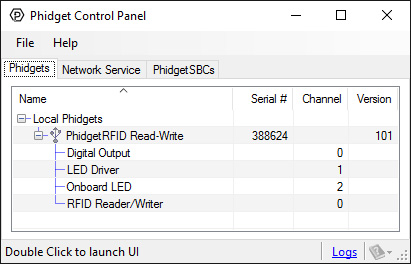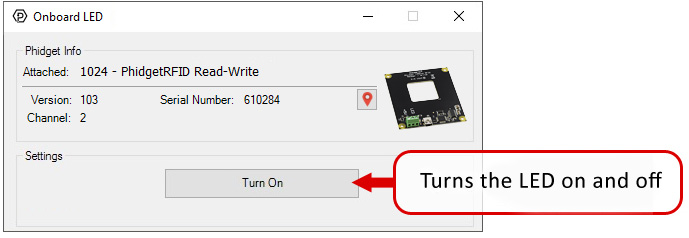1024-0 User Guide: Difference between revisions
No edit summary |
m (Mparadis moved page 1024 User Guide to 1024-0 User Guide without leaving a redirect) |
||
| (21 intermediate revisions by 3 users not shown) | |||
| Line 1: | Line 1: | ||
__NOINDEX__ | |||
__NOTOC__ | |||
<metadesc>You can read and write to RFID tags up to 6cm away with the Phidget RFID read/write. Supports EM4100 series, ASCII and ISO11785 FDX-B protocols.</metadesc> | |||
[[Category:UserGuide]] | [[Category:UserGuide]] | ||
==Part 1: Setup== | |||
<div class="phd-deck-sequence"> | |||
{{PT1_1024_CHOOSE}} | |||
{{PT1_1024_WIN}}{{PT1_1024_MAC}}{{PT1_1024_LNX}} | |||
</div> | |||
== | == Part 2: Using Your Phidget == | ||
===Phidget Control Panel=== | |||
You can use the [[Phidget Control Panel]] to explore your device's functionality. | |||
1. After opening the Phidget Control Panel you will find the following channels: | |||
[[Image:1024_Panel.jpg|link=|center]] | |||
{{ | 2. Double click on a channel to open an example program. | ||
{{UGC-Start}} | |||
{{ | {{UGC-Entry|Digital Output | Switchable 5V output (max current 400mA) | ||
| | |||
In your Control Panel, double click on "Digital Output": | |||
[[Image:1024-DigitalOutput.jpg|800px|center|link=]]}} | |||
{{ | {{UGC-Entry|LED Driver | Switchable 5V output (max current 16mA) | ||
| | |||
In your Control Panel, double click on "LED Driver": | |||
[[Image:1024-DigitalOutput.jpg|800px|center|link=]]}} | |||
{{ | {{UGC-Entry|Onboard LED | Turn on green LED beside USB connector | ||
| | |||
In your Control Panel, double click on "Onboard LED": | |||
[[Image:1024-OnboardLED.jpg|800px|center|link=]]}} | |||
= | {{UGC-Entry|RFID Reader/Writer| Read or write data from an RFID tag | ||
| | |||
In your Control Panel, double click on "RFID Reader/Writer": | |||
[[Image:1024-RFID.jpg|800px|center|link=]]}} | |||
{{UGC-End}} | |||
{{UG-Part3}} | |||
== | == Part 4: Other Resources == | ||
{{UGC-Start}} | |||
{{UGC-Entry|RFID Guide| | |||
| | |||
View our [[RFID Guide]] for an in-depth look at Phidget RFID systems. | |||
}} | |||
{{UGC-Firmware}} | |||
{{UGC-Entry|FCC Compliance| | |||
| | |||
{{1024-FCC-Table|1024_0|SUT1024-0}} | |||
{ | |||
| | |||
| | |||
:This device complies with Part 15 of the FCC Rules. Operation is subject to the following two conditions: | :This device complies with Part 15 of the FCC Rules. Operation is subject to the following two conditions: | ||
| Line 133: | Line 74: | ||
:This unit was tested with shielded cables on the peripheral devices. Shielded cables must be used with the unit to ensure compliance. | :This unit was tested with shielded cables on the peripheral devices. Shielded cables must be used with the unit to ensure compliance. | ||
}} | |||
{{UGC-End}} | |||
Latest revision as of 19:00, 16 September 2024
Part 1: Setup
Part 2: Using Your Phidget
Phidget Control Panel
You can use the Phidget Control Panel to explore your device's functionality.
1. After opening the Phidget Control Panel you will find the following channels:

2. Double click on a channel to open an example program.
In your Control Panel, double click on "Digital Output":

In your Control Panel, double click on "LED Driver":

In your Control Panel, double click on "Onboard LED":

In your Control Panel, double click on "RFID Reader/Writer":

Part 3: Create your Program
Part 4: Other Resources
View our RFID Guide for an in-depth look at Phidget RFID systems.
Firmware Upgrade
MacOS users can upgrade device firmware by double-clicking the device row in the Phidget Control Panel.
Linux users can upgrade via the phidget22admin tool (see included readme for instructions).
Windows users can upgrade the firmware for this device using the Phidget Control Panel as shown below.

Firmware Downgrade
Firmware upgrades include important bug fixes and performance improvements, but there are some situations where you may want to revert to an old version of the firmware (for instance, when an application you're using is compiled using an older version of phidget22 that doesn't recognize the new firmware).
MacOS and Linux users can downgrade using the phidget22admin tool in the terminal (see included readme for instructions).
Windows users can downgrade directly from the Phidget Control Panel if they have driver version 1.9.20220112 or newer:

Firmware Version Numbering Schema
Phidgets device firmware is represented by a 3-digit number. For firmware patch notes, see the device history section on the Specifications tab on your device's product page.

- If the digit in the 'ones' spot changes, it means there have been bug fixes or optimizations. Sometimes these changes can drastically improve the performance of the device, so you should still upgrade whenever possible. These upgrades are backwards compatible, meaning you can still use this Phidget on a computer that has Phidget22 drivers from before this firmware upgrade was released.
- If the digit in the 'tens' spot changes, it means some features were added (e.g. new API commands or events). These upgrades are also backwards compatible, in the sense that computers running old Phidget22 drivers will still be able to use the device, but they will not be able to use any of the new features this version added.
- If the digit in the 'hundreds' spot changes, it means a major change has occurred (e.g. a complete rewrite of the firmware or moving to a new architecture). These changes are not backwards compatible, so if you try to use the upgraded board on a computer with old Phidget22 drivers, it will show up as unsupported in the Control Panel and any applications build using the old libraries won't recognize it either. Sometimes, when a Phidget has a new hardware revision (e.g. 1018_2 -> 1018_3), the firmware version's hundreds digit will change because entirely new firmware was needed (usually because a change in the processor). In this case, older hardware revisions won't be able to be upgraded to the higher version number and instead continue to get bug fixes within the same major revision.

|
Phidgets Inc |
| 1024_0 | |
| FCC ID: SUT1024-0 |
- This device complies with Part 15 of the FCC Rules. Operation is subject to the following two conditions:
- (1) This device may not cause harmful interference, and
- (2) This device must accept any interference received, including interference that may cause undesired operation.
- Note: The manufacturer is not responsible for any radio or TV interference caused by unauthorized modifications to this equipment. Such modifications could void the user’s authority to operate the equipment.
- The user is cautioned that any changes or modifications not expressly approved by the party responsible for compliance could void the user’s authority to operate the equipment.
- This equipment has been tested and found to comply with the limits for a Class B digital device, pursuant to part 15 of the FCC Rules. These limits are designed to provide reasonable protection against harmful interference in a residential installation. This equipment generates, uses and can radiate radio frequency energy and, if not installed and used in accordance with the instructions, may cause harmful interference to radio communications. However, there is no guarantee that interference will not occur in a particular installation. If this equipment does cause harmful interference to radio or television reception, which can be determined by turning the equipment off and on, the user is encouraged to try to correct the interference by one or more of the following measures:
- • Reorient or relocate the receiving antenna.
- • Increase the separation between the equipment and receiver.
- • Connect the equipment into an outlet on a circuit different from that to which the receiver is connected.
- • Consult the dealer or an experienced radio/TV technician for help.
- This unit was tested with shielded cables on the peripheral devices. Shielded cables must be used with the unit to ensure compliance.
